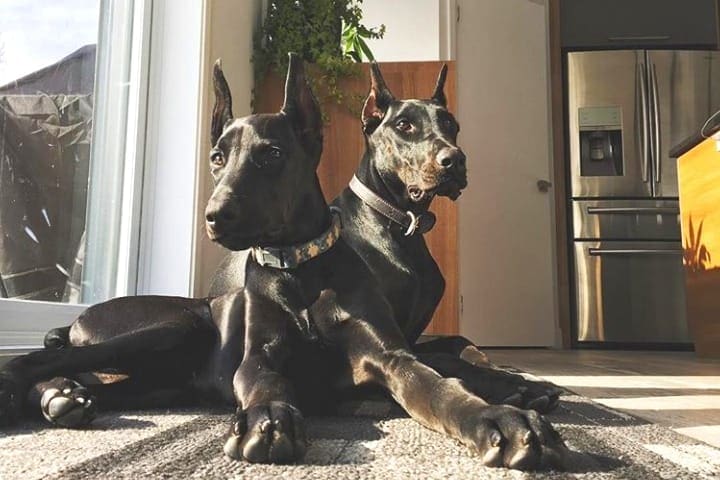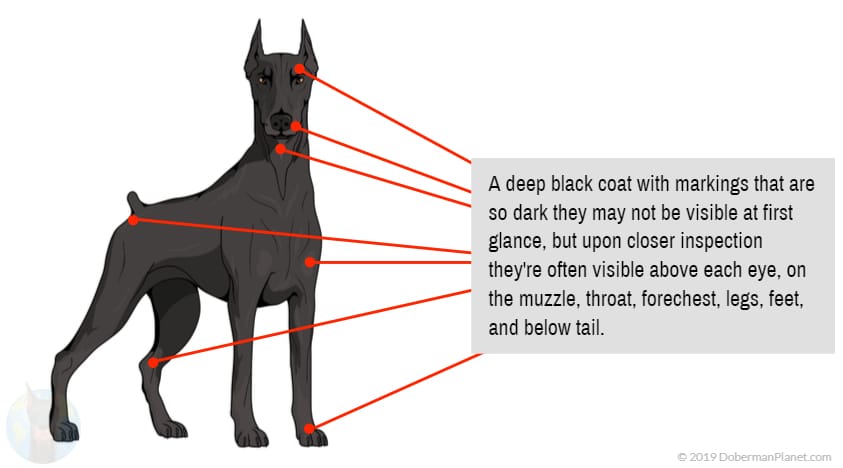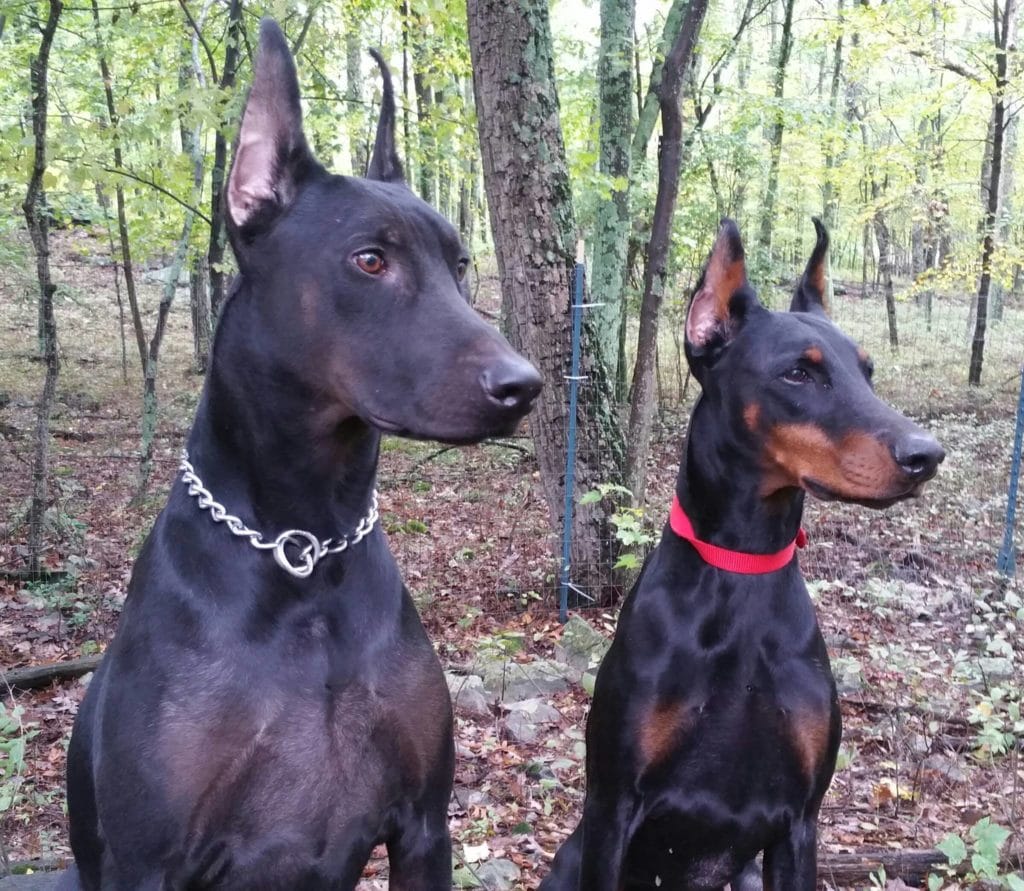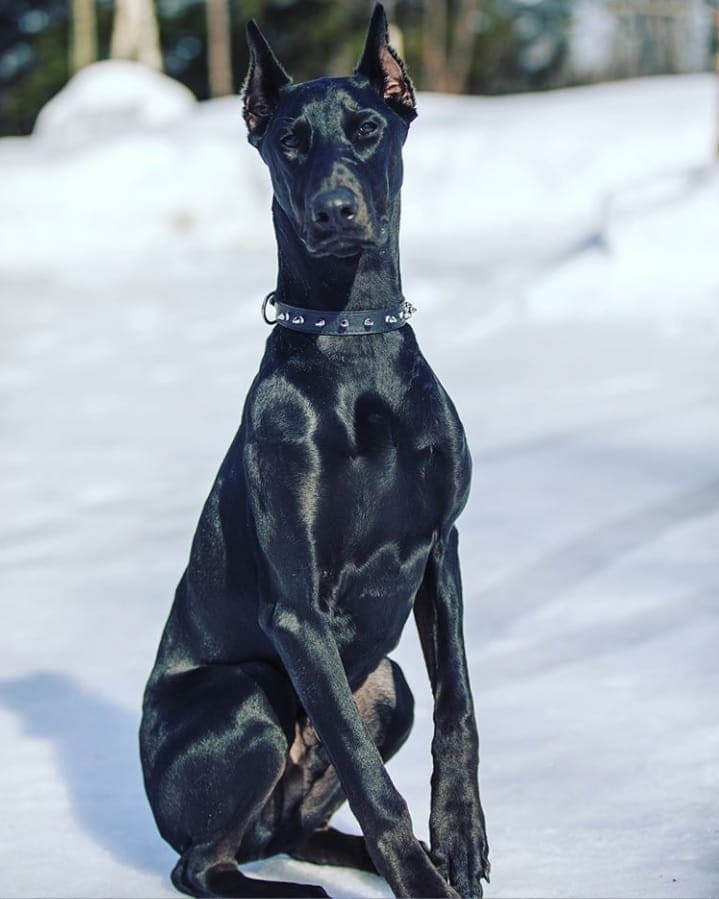
You know what it’s like when you see something and do a double-take because you’re not sure what you just saw? An all-black Doberman is like that to a lot of people. Many people have come to me and claimed they saw an all-black Doberman, asking if this is possible. So is this really possible, and if so, how rare are they?
Can a Doberman be all-black? It is possible for a Doberman to appear to be entirely black in color. However, all-black Dobermans will almost always still have discernible rust-colored markings upon close inspection. This is caused by too much pigmentation; a condition called melanism.
The all-black Doberman is not recognized as part of the “breed standard” by the American Kennel Association—meaning the AKC does not consider them to be a true Doberman. Because of the potential for additional health problems and temperament issues due to increased amounts of inbreeding with the all-black varieties, many Doberman experts will advise against purchasing one.
All-Black Dobermans Are Rare
I can tell you with confidence that from my experience, these dogs are certainly hard to find, but unfortunately, we don’t really know exactly how rare they are. Since they aren’t considered to be a true Doberman by many of the national kennel clubs, records aren’t kept as to how often the all-black Doberman appears and how many are currently in existence. We just have no way of knowing if they’re a one in a thousand, one in a hundred thousand, or one in a million dog.
These dogs may, on rare occasion, show up in a rescue center or one might appear in a litter from a reputable breeder. However, be cautious if you find a litter containing multiple all-black Dobermans puppies. It’s likely that these are either not pure-bred Dobermans or inbreeding has occurred to produce such a large quantity of all-black dogs. Inbreeding leads to serious health and temperament issues.
They Aren’t Completely Black
Many Doberman breeders will tell you that very few of these dogs are truly completely black. They insist that if you look closely, you will see faint tan markings. As one breeder says
“In my 34 years in the breed I have never seen an all black dog. There are some dogs with very dark markings, almost black but the markings are still discernible.”
– Holly Schorr. “All black Dobes” DPCA.org (source)
Dogs that appear to be an all-black Doberman are more often not purebred. I’m certainly not saying that an all-black purebred Doberman is impossible to produce, just that it isn’t likely. Breeding a Doberman with another all-black dog can lead to an all-black dog that looks very similar to a Doberman, but isn’t truly a purebred. Sometimes these “look-alikes” will be labeled as all-black purebred Dobermans by non-ethical breeders.

Many Breeders Avoid All-Black Dobermans
Breeders want their dogs to not only conform to the breed standards by the national kennel clubs but also strive to produce the healthiest dogs possible. If their dogs don’t conform to the Doberman standards then they cannot compete in competitions or shows, and holding a championship title in a dog show is a major plus for a breeder. Also, it can be argued by others that they aren’t even true Dobermans since they don’t conform to the breed standards.
Many breeders avoid breeding all-black Dobermans as they fear potential health issues due to increased amounts of inbreeding in the past with these dogs. The same is often true with all-white Dobermans.
Unfortunately, there are non-ethical breeders who purposely breed all-black Dobermans at any cost (disregarding health, temperament, etc) and attempt to sell them at an inflated price, citing how rarely they occur. These breeders will often engage in dangerous in-breeding practices to produce these dogs.
It should be noted however that ethical breeders do exist who specialize in the “alternative” Doberman colors such as white or all-black. These ethical breeders will go to great lengths to avoid inbreeding and will health test their dogs extensively. I wish I could say this was the norm, but unfortunately, many wreckless backyard breeders trying to produce more profitable puppies have cast a shadow of doubt over all alternative color breeders, even when it isn’t necessarily deserved.
The All-Black Doberman Controversy
There are heated arguments within the Doberman world almost daily, about whether breeding these all-black dogs is ethical. Here are the two sides to this controversy that you’re most likely to see.
Pro-Alternative Color Argument
Those who are in favor, or at a minimum, not opposed to breeding all-black Dobermans will tell you that it’s unfair to judge an entire color of a dog as “unhealthy” just because of their color. They will also cite multiple alternative color breeders who exist that go to great lengths to make sure they have healthy stock and perform in-depth health tests. They may also cite one of the many studies out there that exist which show that all-black animals in nature are generally healthier than other colors. They claim that the notion of alternative Doberman colors being less healthy is a stigma that needs to be abolished.
Anti-Alternative Color Argument
Those who are against breeding all-black Dobermans will very often state that it’s not ethical to do so due to inbreeding in generations past. They’ll also say that no matter how careful a breeder is in selecting breeding stock, it’s almost impossible to breed a dog whose color is this rare without some inbreeding in the dog’s lineage and inbreeding is known to be associated with health and temperament problems. They also take the stance that this will negate any potential benefits in health that an all-black dog has, as cited in the previously mentioned studies. Lastly, they’ll say that when breeders are trying to produce one specific, very rare color, they are often forced to pair parents together who are not ideal in terms of temperament due to limited choices in breeding stock of that color.
The controversy surrounding this topic is so heated in the Doberman world that some breeders discourage even mentioning the non-standard colors. So, in the end, it’s up to you to make up your own mind!

How Color is Determined
Think of all the dogs you have seen—everything from a white poodle to a completely black terrier and all the hues in-between. And all that diversity begins with two pigments—black and red.
Both colors are forms of melanin. Black pigment is also called eumelanin while red is phaeomelanin, and all canine fur colors come from different combinations of eumelanin and phaeomelanin, or from red and black.
Hair follicles have melanocyte cells in them, and when the hair grows, those cells add the melanin that determines the color of the fur. The darker the hair, the more melanin has been added. Tips of hair either lighter or darker than the shaft are the result of unsteady melanin production.
The Role of Genetics in Coat Color
Genes also have a role to play. They can modify either pigment by diluting its strength. Colors such as brown, grey, or pale brown are created when genes modify eumelanin levels. Different genes control the intensity of the red, or phaeomelanin, pigment. These colors include the deep red of Irish Setters to the tan of the Golden Retriever.
When the cells don’t produce any pigment, you will see white hair. In most dogs, only portions of their coats lack color, otherwise known as markings. But when you see a completely white dog, they lack both kinds of pigmentation in their fur.
On the other hand, dogs that have no red pigmentation are completely black, which is a condition called melanism. While an all-black dog is missing one color, an all-white Dobie is missing both red and black pigmentation.
There is nothing inherently wrong with a lack of pigments or too much pigment—if that’s a true trait of the breed. For example, a dalmatian lacks red pigmentation except for the black spots. The loci, or place for that on the dog’s chromosome, is called the H or harlequin loci.
However, the standard for a Dobie includes pigmentation, specifically the common black and tan that we associate with them. Let’s look at the different Doberman colors.
The Different Colors of Dobermans
There are many colors of the Doberman—as little as four and as many as seven, depending on who you ask. For a complete list of all the Doberman colors, see my article all about every type of Doberman color in existence here.
Dobie’s also don’t always have identical areas where the tan coloring appears. Some Dobies have more tan coloring in their coats than others. Also, the tan markings themselves can vary in darkness, with European Dobermans often having darker markings.
Here are the most common Doberman Colors:
- Black – The black and tan is the most common Doberman color. This is the one you’re most used to seeing. Some prefer the word rust instead of tan, but it’s referring to the same thing.
- Red – This is sometimes referred to as a “Chocolate Doberman” and is the next most commonly seen Doberman. The red hair can be everything from copper to chocolate. Europeans, by the way, also sometimes call them brown—fitting since European Dobermans are typically a bit darker in color.
- Fawn – These aren’t seen as often as the first two colors. The fawn color is really just a diluted red color. You might also hear this called “Isabella”.
- Blue – A bluer Doberman has its black pigment diluted. They are sometimes called a Gray Doberman. Blue Dobermans are prone to Color Dilution Alopecia, a condition in which the hair becomes brittle and breaks easily.
Let’s take a look at what the breed standards say for the color of Dobermans so we can better understand the all-black Dobies.
To find out your dog’s specific genetics and what color puppies they are able to produce, I recommend doing a simple home DNA health test. Besides telling you all the colors of puppies they can make, it’ll also give you priceless insight into your dog’s health. See my guide on how to DNA test your Doberman here.

Doberman Breed Standards on Color
The AKC (American Kennel Club) says the tan areas must appear on the muzzle, above each eye, on all four legs, and in the throat and chest, plus a small patch of tan below the tail.
If there’s a white patch on the chest, it gets measured at competitions to ensure that it does not exceed breed standards. Yes, seriously. The white patch on the chest of a Doberman should not exceed a half-inch square in size.
The AKC is very specific about what colors meet the standard for a Doberman
“Allowed Colors-Black, red, blue, and fawn (Isabella). Markings-Rust, sharply defined, appearing above each eye and on muzzle, throat and forechest, on all legs and feet, and below tail. White patch on chest, not exceeding ½ square inch, permissible. Disqualifying Fault – Dogs not of an allowed color.”
– Official Standard of the Doberman Pinscher. American Kennel Club (source).
The AKC for a Dobie is very specific. But what if your dog is missing a marking that the breed standard says it should have? Or what if the white patch on the chest is too big? Is it still a Doberman? Of course, it is. He wouldn’t qualify for a dog show—but no one would suggest you don’t have a Doberman.
There’s a host of things in the AKC standard that might disqualify your Dobie. There are standards for height, head, topline, body, forequarters and hindquarters, gait, and temperament. Two pages, single-spaced, in tiny font. Few Dobermans would meet all those standards.
Obviously, you can have a Doberman that doesn’t meet every standard and is still a Doberman. If you agree with that logic, then Dobermans can be all-black or all-white. Right?
Coat Color Can Change with Age
It’s also important to note that a Doberman’s color can change as the dog ages. This is common when they lose their “puppy coat”, which usually occurs during the first 18 months of life. Subtle changes can occur during this time such as lightening or darkening of their markings or the addition of occasional white hairs. A complete color change is not possible, however.
Also, very subtle changes in color can occur in the form of lighter colors during the summer months with more exposure to the sun and darker colors in the winter. As the dog reaches the latter part of its life, it is common for additional white hairs to appear, especially around the face.
Final Thoughts
I think most people would agree that you can have a Doberman who appears all-black. Some folks will suggest that an all-black dog is not a true pure-bred Doberman and some may even go further and say owning one isn’t ethical.
I say that when you see someone walking an all-black Doberman, you aren’t just looking at a dog, but something else—companionship, loyalty, and love. No matter what their color is.
Related Questions
How much do all-black Dobermans cost? All-black, or melanistic, Dobermans will cost a similar amount as the more common colored Dobermans, or between about $1500 and $2500.



Are solid red Doberman considered the same as all black or all white?
Meaning, are the viewed with the same stigma?
So happy to find your website I’ve owned dobies since 1994 . Three red females in all my last one Maggie Mae got cancer and had to be put down shy of her 11th birthday . I’m retired now living on my family farm in and looking for another pup but there’s no breeders around close to me.